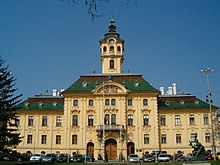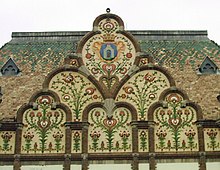Secession style architecture in Hungary
The architecture of the Secession style in Hungary developed its own formal language at the end of the 19th century, which differed from the architecture of the Art Nouveau and the Vienna Secession . Especially in Budapest , but also in the other cities of Hungary , a large number of buildings were built in this style, which was also known as the Budapest Szecesszió .

These are buildings that still shape the Budapest cityscape with their colorful tiles and bricks . The building ceramics, often with floral decorations, were made by the Zsolnay Porcelain Manufactory . Pioneer of the new style was the architect Odon Lechner , whose buildings for the World Heritage List of UNESCO are proposed.
history
With the Hungarian-Austrian balance of 1867 was Hungary until 1918 the second major component of the Austro-Hungarian dual monarchy of Austria-Hungary . As Prime Minister (1875–1890), Kálmán Tisza carried out extensive reforms to modernize the country in the areas of economy, justice, social affairs and politics. In addition, there was a process of Magyarization of the eastern part of the country, which also included Transylvania and Slovakia .
As the capital, Budapest was finally merged from the two halves of Buda (with Old Buda ) and Pest. The population in the entire urban area increased sevenfold between 1840 and 1900 and rose to around 730,000. To mark the millennium of the Hungarians '"conquest" (the so-called Millennium) in 1896, numerous major projects were completed in connection with the Budapest Millennium Exhibition in 1896 , such as Heroes' Square and the Budapest Metro , the first subway on the European continent .

At the same time there was a renunciation of historicism in the architectural field and the development of the Hungarian Secession style. Lechner had received a lot of recognition for the design of the town hall in Szeged in 1882 . In 1891 he and Gyula Pártos won the competition for the Hungarian Museum of Decorative Arts. Both developed an "East Hungarian" architectural style, the decor of which consisted of glazed bricks, building ceramics made of pyrogranite (weatherproof stoneware ) from the Zsolnay factory and borrowings from Indian, Persian, Moorish and Hungarian folk art.
Architects of the Secession style
- Ödön Lechner (1845–1914) has been developing the Hungarian Secession style since 1891.
- Sándor Baumgarten (1864–1928), Palais Lloyd and u. a. 300 schools.
- Lipót Baumhorn (1860–1932), twelve of the synagogues he built are still standing today, including the synagogue of Szeged (1903), which is considered the high point of his work.
- Dezső Jakab (1864–1932), important designs with M. Komorr.
- Károly Kós (1883–1977), member of the Fiatalok group, won the competition for Wekerletelep. He also worked as a graphic artist and author.
- Marcell Komor (1868–1944), important designs with Dezső Jakab, was a victim of National Socialism .
- Béla Lajta (1873–1920) designed the Parisiana orfeum, a building that in 1908 already pointed towards Art Deco .
- Béla Málnai (1878–1941), designer of residential buildings, editor of a magazine.
- Gyula Pártos (1845–1916), an important colleague of Lechner.
- Samu Pecz (1854–1922) also worked as a university professor.
- J. Ferenc Raichle (1869–1960), worked in Szeged and Subotica .
- Frigyes mirror (1866–1933), also inspired by the French Art Nouveau house Lindenbaum.
- Emil Vidor (1867–1952), architecture with French, Belgian and German influences.
Note: In the course of Magyarization, the names of the architects were also adapted to Hungarian usage: For example, Kosch became Kós and Leitersdorfer became Lajta.
Hungarian Art Nouveau buildings (selection)
| Building | Place location |
Construction year | architect | Art | Remarks | image |
|---|---|---|---|---|---|---|
|
Iparművészeti Múzeum Decorative Arts Museum |
Budapest | 1893-1896 | Lechner , Pártos | museum | nominated for world heritage |

|
| Szent László Church Szent László-templom |
Budapest, 10th district |
1894-1896 | Lechner | church | nominated for world heritage |

|
| Magyar Állami Földtani Intézet Geological Museum |
Budapest | 1896-1899 | Lechner | museum | nominated for world heritage |

|
|
Postal savings bank Postatakarékpénztár |
Budapest | 1899-1902 | Lechner | Bank building | nominated for world heritage |

|
|
Városháza Town Hall |
Kecskemét | 1892-1894 | Lechner | administration | nominated for world heritage |

|
|
Zsinagóga synagogue |
Szeged | 1901-1903 | Tree horn | synagogue | fourth largest active synagogue in the world |

|
| synagogue |
Subotica , Serbia |
1901-1903 | Komor , Jakab | synagogue | Forming the cityscape, profane |

|
| Palace of the Palatul Prefecturii Prefecture |
Târgu Mureș , Romania |
1905-1907 | Komor, Jakab | administration | Forming the cityscape |

|
|
Parisiana orfeum (formerly) Új színház |
Budapest | 1908-1909 | Lajta | theatre | Early work of Art Deco |

|
|
Palais Lloyd Palatul Lloyd |
Timișoara , Romania |
1910-1912 | Tree horn | Commercial building | Polytechnic University, Rectorate |

|
| Mausoleum for Sándor Schmidl | Budapest, jew. graveyard |
1902-1903 | Lajta | mausoleum | Building ceramics from Zsolnay |

|
literature
- Rudolf Klein : Zsinagógák Magyarországon 1782–1918: fejlődéstörténet, tipológia és építészeti jelentőség / Synagogues in Hungary 1782–1918. Genealogy, Typology and Architectural Significance . TERC, Budapest 2011, ISBN 978-963-9968-01-1 .
- András Székely , Harald A. Jahn (photographs): Art Nouveau in Budapest: the secession in Hungary's metropolis at the turn of the century . Frankfurt am Main 1995. ISBN 3-88379-698-0 .
- Ákos Moravánszky : The architecture of the turn of the century in Hungary and its relationship to the Viennese architecture of the time . VWGÖ, Vienna, 1983.
